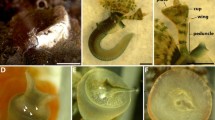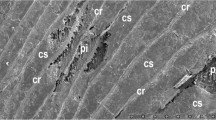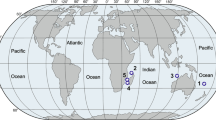Summary
Ultrastructural examination of original and regenerated branch tips of the gorgonianLeptogorgia virgulata reveals that spicule formation begins with the aggregation of scleroblasts in the mesoglea. Calcite crystal deposition occurs within a Golgi vacuole containing organic matrix. Vacuole size increases while matrix incorporation and subsequent crystal growth continue, filling the vacuole. At approximately this time, the scleroblasts dissociate and “wart” formation begins. Further spicule growth stretches the cell into a thin envelope. Fusion of vacuole and plasma membrane followed by breach formation during spicule growth, as well as scleroblast atrophy or migration from mature spicules, result in the transition of the spicule from the intracellular to the extracellular environment. The results also reveal aborted spicules and digestive bodies, implying possible relationships among calcification, detoxification, and waste management.
Similar content being viewed by others
References
Bayer FM (1961) The shallow-water Octocorallia of the West Indian region. Martinus Nijhoff, The Hague, pp 1–373
Bé AWH, Hemleben C (1970) Calcification in a living planktonic foraminiferaGlobigerinoides sacculifer (BRADY) N Jb Geol Palaont Abh, 134:221–234
Bourne CG (1899) Studies on the structure and formation of the calcareous skeleton of the Anthozoa. Quart J Micr Sci 41:499–555
Dunkelberger DG, Watabe N (1974) An ultrastructural study on spicule formation in the Pennatulid colonyRenilla reniformis. Tiss and Cell 6:573–586
Dyson RD (1978) Cell biology, a molecular approach, Second edition. Allyn and Bacon Inc, Boston, pp 422
Gilula NB, Epstein ML (1976) Cell-to-cell communication, gap junctions and calcium. In: Calcium in biological systems. Symposia of the Society of Expt Biol No. 30. Cambridge Univ Press, Cambridge England, pp 257–272
Kawaguti S (1964) Electron microscopy on the spicules and the polyp of the gorgonian,Euplexaura erecta. Biol J Okayama Univ 10:23–38
Kawaguti S (1969) Electron microscopy on a soft coral,Heteroxenia elisabethae Kolliker. Biol J Okayama Univ 15:25–35
Kawaguti S, Kamishima Y (1973) Electron microscopy on a gorgonian coral,Anthoplexaura dimorpha. Publ Seto Mar Biol Lab 20:785–793
Lewis PR, Knight DP (1976) Staining methods for sectioned material. Elsevier, Amsterdam, pp 159–163
Neff JM (1971) Ultrastructural studies of the secretion of calcium carbonate by the serpulid polychaete worm,Pomatoceros caeruleus. Z Zellforsch 120:160–186
Pienaar RN (1976) The rhythmic production of body covering components in the Haptophycean flagellateHymenomonas carterae. In: Watabe N, Wilbur KM (eds) The mechanisms of mineralization in the invertebrates and plants. University of South Carolina Press, Columbia, South Carolina, pp 203–230
Shimizu M, Yamada J (1980) Sclerocytes and crystal growth in the regeneration of sea urchin tests and spines. In: Omori M, Watabe N (eds) The mechanisms of biomineralization in animals and plants. Tokai University Press, Tokyo, pp 169–178
Simkiss K (1974) Calcium translocation by cells. Endeavor 33:119–123
Simkiss K (1976) Cellular aspects of calcification. In: Watabe N, Wilbur KM (eds) The mechanisms of mineralization in the invertebrates and plants. University of South Carolina Press, Columbia, South Carolina, pp 1–31
Simkiss K (1980) Detoxification, calcification and the intracellular storage of ions. In: Omori M, Watabe N (eds) The mechanism of biomineralization in animals and plants. Tokai University Press, Tokyo, pp 13–18
Tompa AS (1976) Calcification of the egg of the land snailAnguispira alternata (Gastropoda: Pulmonata). In: Watabe N, Wilbur KM (eds) The mechanism of mineralization in the invertebrates and plants. University of South Carolina press, Columbia, South Carolina, pp 427–444
Velimerov B, Böhm EL (1976) Calcium and magnesium carbonate concentrations in different growth regions of gorgonians. Mar Biol 35:269–275
Watabe N (1981a) Some problems on the structure and formation of calcium carbonate crystals and their aggregates in the invertebrates. (In Japanese). Mollusc. Res. Spe. Issue. pp. 35–46
Watabe N (1981b) Crystal growth of calcium carbonate in the invertebrates. Prog Crystal Growth Charact 4:99–147
Watabe N, Meenakshi VR, Blackwelder PL, Kurtz EM, Dunkelberger DG (1976) Calcareous spherules in the gastropod,Pomacea paludosa. In: Watabe N, Wilbur KM (eds) The mechanisms of mineralization in the invertebrates and plants. University of South Carolina Press, Columbia, South Carolina, pp 283–308
Wheeler AP, George JW, Evans CA (1981) Control of calcium carbonate nucleation and crystal growth by soluble matrix of oyster shell. Science 212:1397–1398
Wilbur KM (1976) Recent studies of invertebrate mineralization In: Watabe N, Wilbur KM (eds) The mechanisms of mineralization in the invertebrates and plants. University of South Carolina Press, Columbia, South Carolina, pp 79–108
Wilbur KM (1980a) Invertebrate skeletal matrix — some recent studies. Biomin Newsletter 2:3–4
Wilbur KM (1980b) Cells, crystals and skeletons. In: Omori M, Watabe N (eds) The mechanisms of biomineralization in animals and plants. Tokai University Press, Tokyo, pp 3–11
Wilbur KM, Simkiss K (1979) Carbonate turnover and deposition by metazoa. In: Trudinger PA, Swaine DJ (eds) Biochemical cycling of mineral forming elements. Elsevier, New York, pp 69–106
Woodland W (1905) Studies in spicule formation II. Spicule formation inAlcyonium digitatum; with remarks on the histology. Quart J Micros Sci 49:283–304
Author information
Authors and Affiliations
Additional information
Contribution No 436, Belle W. Baruch Institute for Marine Biology and Coastal Research, University of South Carolina, Columbia, South Carolina, 29208, USA
Rights and permissions
About this article
Cite this article
Kingsley, R.J., Watabe, N. Ultrastructural investigation of spicule formation in the gorgonianLeptogorgia virgulata (Lamarck) (Coelenterata: Gorgonacea). Cell Tissue Res. 223, 325–334 (1982). https://doi.org/10.1007/BF01258493
Accepted:
Issue Date:
DOI: https://doi.org/10.1007/BF01258493




